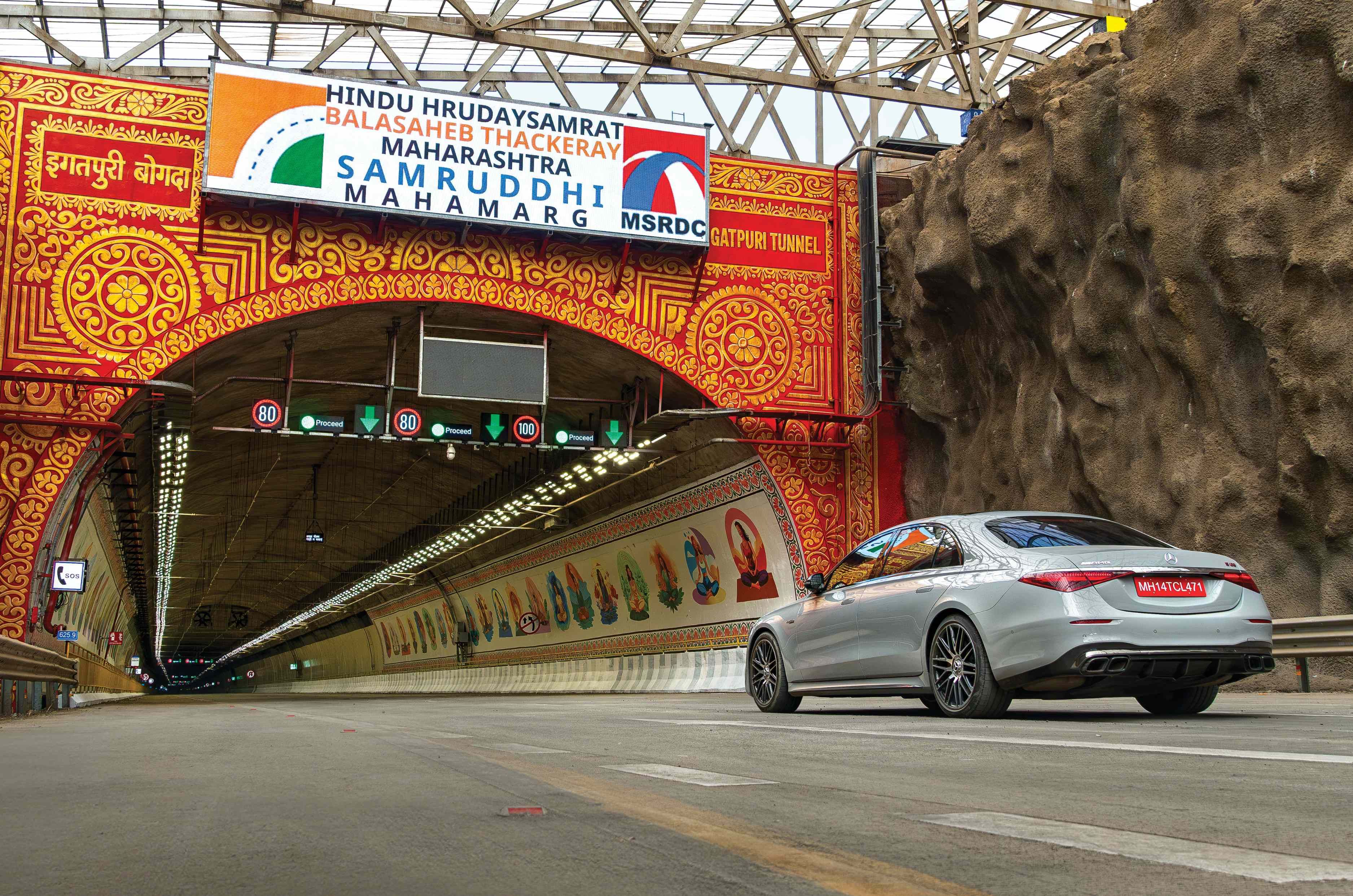
The long-awaited Phase 3 and final leg of the Hindu Hrudaysamrat Balasaheb Thackeray Maharashtra Samruddhi Mahamarg is finally complete, and what’s special about this leg is the brand-new Igatpuri tunnel that bypasses the Kasara Ghat. It can reduce a minimum of 30 minutes of travel time while being a lot safer. Naturally, we wanted to drive through it, and we were lucky enough to get early access to experience the 7.7km tunnel before it was open to the public.
Now, at Autocar, we like our tunnels because they allow us to be a bit childish and make some noise. And what better car to make noise than a full-blown AMG V8? More specifically, the Mercedes-AMG S 63 E-Performance. An 802hp missile that can rip through time with its thundering and rumbling twin-turbo V8.

‘Sport Plus’ engaged, ‘Race Start’ ready and the engine trembling to be let loose, the first V8 to rumble through the tunnel was nothing short of spectacular. The S 63 screamed in fury as the echo of the exhaust reverberated all around the mountain. Yes, this is an S-Class with some superb sound deadening, but when you have nearly eight kilometres of what is effectively a long subwoofer, nothing can mute the audio. Of course, since the road was closed to the public, I could push it and see what this rowdy S could really do. Turns out, a lot. With over 1,400Nm of torque, there is no dearth of power and punch, and even in 8th gear, it has power in reserve.

The tunnel lights were a blur, as was the time I took to get out of the other side. It’s surreal and a bit eerie when you are the only car in a dark tunnel. But, to get a closer look, you need to shut out the noise, which, on the S 63, is a simple twist of the drive mode.
For my second slow run, I switched to ‘EL’ mode, which puts the leash on the burly V8 and uses the 13kWh battery pack with an electric motor. The plug-in hybrid nature allows for silent drives and helps save some of that precious high-octane fuel.

The tunnel has been constructed within the mountains of Igatpuri, and given the challenging topography and terrain, new ways were used to dig through the mountain rocks. Since the tunnel’s dimensions were some of the largest, a conventional drill wasn’t used.
Maharashtra State Road Development Corporation (MSRDC) used a new technique called the ‘New Austrian Tunneling Method’, or ‘NATM’, as it is popularly known. Instead of a drill, this method uses explosives, which are drilled into the rock in a special manner and then blasted out to make space.
Also, the tunnel is constructed downhill towards Mumbai, which helps the monsoon water from the ever-pouring Igatpuri flow down with ease.

The entry from Igatpuri features a roughly 200-metre shaded area, which helps drivers adjust their eyes for the transition from bright daylight to the darker tunnel and also helps keep the tunnel entry dry during the monsoons.

Once that ends, you might imagine it is the start of the tunnel, but technically, this is called a cut and cover. Essentially, this 240-odd-metre concrete section mimics the tunnel dimensions for added structural strength. Like most of the expressway’s walls, the tunnel, too, has handpainted art that adds aesthetic beauty.

Post the cut and cover is the actual carved rock face. A salient feature is mist lines that act as sprinklers and, in case of a fire, can keep going for two hours, giving enough time for emergency help to arrive. There are fire extinguishers set at intervals as well. For added safety, the tunnel is fully lit and features emergency telephones to make SOS calls, a guarded walkway in case you need to walk inside, speakers for announcements, and exhaust ducts and fans.

There are emergency exit shafts as well. Interestingly, since tunnelling was such a challenge and getting heavy machinery at this height was difficult, the construction began by drilling shafts from the side of the mountain, from which two sets of teams entered and dug outwards towards each tunnel end.

The tunnel is designed for 120kph, but there is a 100kph speed limit for LCVs and 80kph for HCVs. Thanks to this, it only takes around 5 minutes to get across the ghat, whereas the old route would take at least 30 minutes or more while dodging trucks, buses and livestock. Construction of the tunnel wasn’t the only challenge. Given the difficult topography, access to the tunnel had to be engineered, too. Viaducts (bridges over valleys) are a common sight on the expressway, with almost 73 of them from Nagpur to Mumbai, but the one after the tunnel is 1.2km long, with four lanes, 200 metres above the ground and constructed over challenging terrain. You, of course, do not feel the transition at all.
Once you exit the tunnel and viaduct, the road is a standard affair with the typical Samruddhi Mahamarg features – broad lanes, barricading and the usual overhead signages. Interestingly, every toll plaza is built on the off-ramps, except the two at each end of the highway. The 701km stretch from Mumbai to Nagpur will now take no more than 8 hours. Earlier, it took 15 hours. The toll amount stands at Rs 2.06 per kilometre, bringing the Mumbai to Nagpur cost to Rs 1,444.

The Hindu Hrudaysamrat Balasaheb Thackeray Maharashtra Samruddhi Mahamarg is truly a mega project, much like the mega car we drove across it in. The road is made with zero compromise, state-of-the-art technology and one primary objective – shrinking time. And that’s also the case with the Mercedes-AMG S 63 E-Performance. It, too, was designed to shrink distances and with advanced technology (F1-derived, no less). And it has the space and comfort for you to enjoy a brilliant road like this.
Also see:

